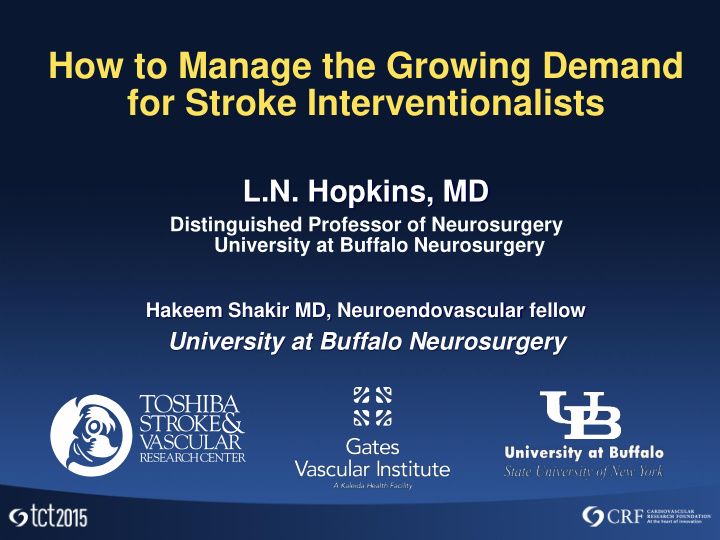



How to Manage the Growing Demand for Stroke Interventionalists L.N. Hopkins, MD Distinguished Professor of Neurosurgery University at Buffalo Neurosurgery Hakeem Shakir MD, Neuroendovascular fellow University at Buffalo Neurosurgery
Disclosure Statement of Financial Interest Within the past 12 months, I or my spouse/partner have had a financial interest/arrangement or affiliation with the organization(s) listed below. Affiliation/Financial Relationship Company • Toshiba • Grant/Research Support • Boston Scientific, Cordis, Abbott • Consulting Fees/Honoraria Vascular, Covidien • Boston Scientific, Valor Medical, Claret • Major Stock Shareholder/Equity Medical, Inc., Augmenix, Endomation, Silk Road, Ostial, Apama, StimSox, Photolitec, ValenTx, Ellipse, Axtria, NextPlain, MedinaMed, Ocular • Board Member • Claret Medical, Inc. • Honorarium • Cordis, Memorial Healthcare System, Complete Conf. Management, Covidien
Tremendous worldwide mortality impact
Not enough Stroke Centers
Acute Ischemic Stroke Is the Most Prevalent Subtype 750,000 strokes per year in the United States Acute Ischemic Stroke 87% Hemorrhagic Stroke 13%
High economic burden on society • Heart disease and stroke cost the nation $312.6 billion/year in health care costs and lost economic productivity.
Acute Ischemic Stroke Burden • Third most common cause of death in industrialized nations • The single most common reason for permanent adult disability • Estimated direct and indirect cost of stroke in the US for 2009- $$$ 68.9 billion • WHO 2002 (World wide) • 15.3 million strokes per year • 5.5 million deaths every year
Evolving Landscape for Stroke • Moving from era of REHABILITATION… In the past, few treatment options available and considerable proportion of stroke survivors remained permanently disabled. • … to new concepts in DIAGNOSIS, MEDICAL THEARPY, and INTERVENTION Since acute occlusion of an intracranial artery is responsible for the clinical manifestations, achieving timely recanalization remains the main aim of acute stroke care. Fast arterial recanalization often leads to dramatic clinical recovery.
Hospitals with neurointerventional ability: Needs 3 or more interventionalists Zaidat et al, Neurology 2012
--Dr. Petr Widimsky
“ Structured training programs that focus on the early intervention of stroke could readily provide the cardiologist with the necessary neurological and anatomical knowledge to effectively treat stroke. Such programs, organized and maintained in a cooperative effort by neurointerventionists and cardiologists, would bridge the gap that we will undoubtedly face in the near future”
Cardiac Innovation • Cardiac care has set a high and constantly rising bar for innovation • Cardiologists and CT-surgeons resourceful in overcoming challenges and quick adopters of new technologies
Why a Vascular Center ?? Number One Crippler and Killer in WNY Heart Head Legs Vascular Disease Specialists Work in Silos Neurosurgery Cell biologists Cardiology Physicists Engineers Radiology Vascular Surgery
Goal #1: Break Down Silos Meetings like TCT mix the disciplines, create synergies Back home , we return to our silos
GOAL Number Two Change the Treatment Paradigm Cell biologists Neurosurgery Cardiology Radiology Physicists Engineers Vascular Surgery Future Vascular Care Delivery…??
Who better to get involved in stroke? • Cardiologists Understand the emergency of recanalization Skill-set to handle technologies for thrombectomy Work on coronary arteries in a moving target
Poised to fill any shortage
Retrospective/Prospective Economics & Outcomes • Multidisciplinary approach • Synergies in Pt care • Synergies in staffing Cross training Team building • Economic synergies Flex labs Combo rooms Dual plane labs
How it will work… • Multidisciplinary stroke teams Endovascular trained neurosurgeons • most comfortable with intracranial anatomy/vasculature leading team. Neurologists Cardiologists Radiologists
Pushing the envelope Innovations in Diagnostics Devices Data Delivery
What Does the Evolving Vascular Specialist Look Like… • Technological advancement will drive the future of vascular neurosurgery practice • Vascular and endovascular Neurosurgeons need to be equipped with the whole tool box CAS - Intracranial Stents - Angioplasty techniques - Flow Diversion - Coil Embolization - Coil Sacrifice - AVM embolization - BTO/WADA testing - http://www.yalemedicalgroup.org/stw/Page.asp?PageID=STW029076
Innovation: Delivery Can we better serve our patients by developing specialized, cross- disciplinary vascular centers of excellence?
Endovascular Neurosurgeons — Evolving Specialty • “Endovascular Surgical Neuroradiology ” Neurosurgery • Neurology • Neuroradiology • Cardiologists??? • • Requirement beyond technical training Understand the breadth of natural history, pathophysiology, • anatomy, critical care, and diagnostic modalities of vascular diseases
Form enhances function Close working proximity of • multidisciplinary vascular specialists • Researchers Basic Research • Clinical resources Collaborative Space
Recommend
More recommend